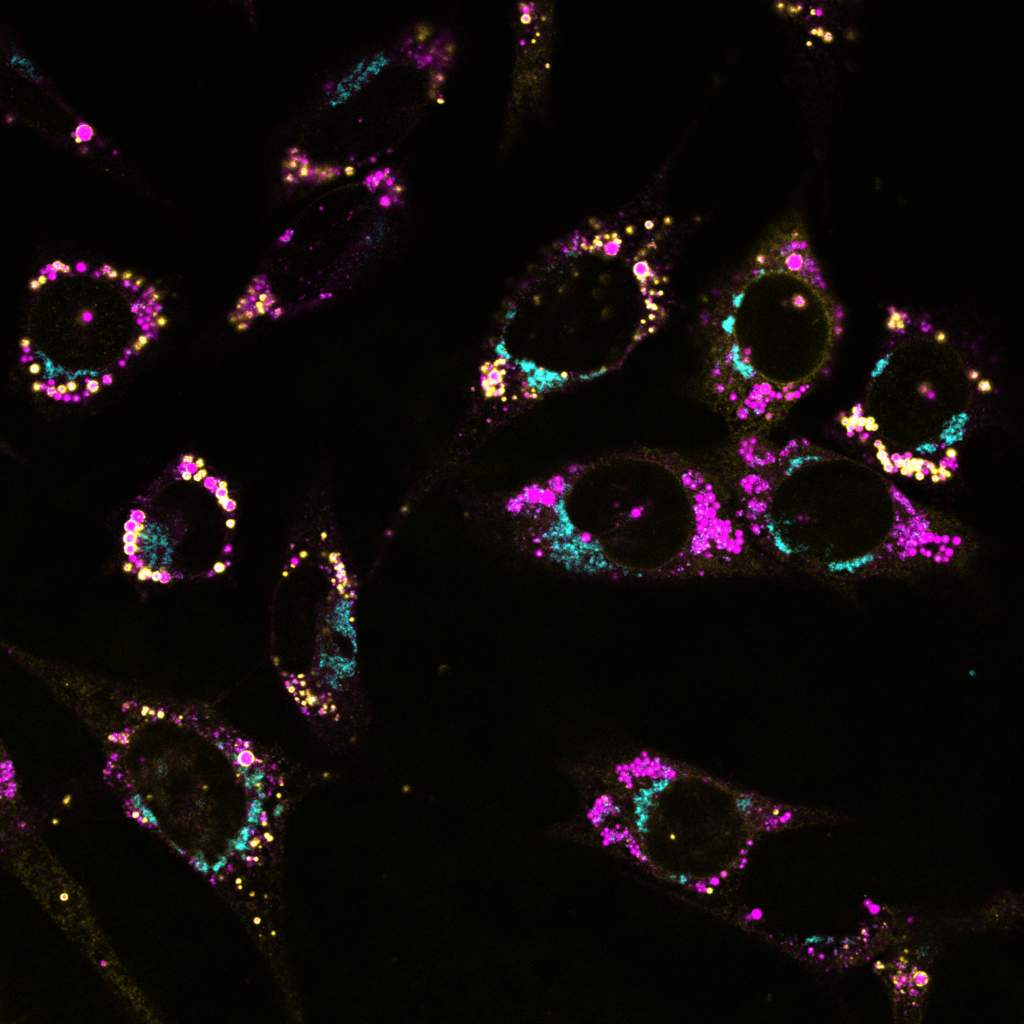The largest genetic risk factor for late-onset Alzheimer's disease is apolipoprotein E (APOE), and researchers Sarah Cohen, PhD, and Ian Windham, a former PhD student from the Cohen group, have made a novel discovery about this protein.
 An image of astrocytes treated with oleic acid. APOE is stained a yellow color and lipid droplets are stained magenta. Image Credit: UNC School of Medicine
An image of astrocytes treated with oleic acid. APOE is stained a yellow color and lipid droplets are stained magenta. Image Credit: UNC School of Medicine
An older person's risk of acquiring the late-onset neurodegenerative disease is increased two or three times if they acquired a genetic mutation known as APOE4 from their parents. Gaining further insight into how APOE4 impacts brain cells could aid scientists in developing efficient treatments and identifying the pathways that lead to increased illness risk.
The link between APOE4, Alzheimer's disease, and fat molecules in the brain termed lipids was studied in great detail over five years by Cohen and Windham.
We discovered that brain cells known as astrocytes are more vulnerable to damage and may even go dysfunctional when APOE4 surrounds their lipid storage centers, and this mechanism could explain why exactly APOE4 increases one’s risk of Alzheimer’s on the cellular level.”
Sarah Cohen, Study Senior Author and Assistant Professor, Department of Cell Biology and Physiology, UNC School of Medicine
The study was published in the Journal of Cell Biology.
The Role of Lipids in the Brain
Lipids, which make up 60% of the dry mass of the brain, are involved in several processes in the brain, including the formation of myelin, the substance that envelops and insulates neurons, and the storage of cellular energy. Lipids are found in specific fat storage areas within astrocytes called lipid droplets.
Lipids can be beneficial, but under some circumstances, they can also become harmful. Toxic lipids are released into the environment by neurons under stress or excitement. The job of astrocytes is to eliminate the harmful lipids that float freely and stop them from building up inside the brain.
Astrocytes cannot carry out their cleaning tasks if they sustain injury or develop any kind of malfunction. This makes it impossible for other brain cells known as microglia to remove amyloid beta plaques from the brain, which is another cause of Alzheimer's disease.
Seeing APOE in Real-Time
Astrocytes are the producers of APOE. The protein regulates the release and movement of lipids across different types of brain cells, much like an Uber or taxi. Windham and Cohen were interested in determining the precise fate of the lipids within the astrocytes.
Leading the way, Windham developed a labeling and tagging technology that made it possible to observe astrocytes' internal workings under a microscope.
Tagging APOE with green fluorescent protein allowed us to see the different places APOE goes while inside living cells.”
Ian Windham, Study First Author and Postdoctoral Fellow, Rockefeller University
The researchers gave oleic acid, an omega-9 fatty acid that the body naturally produces, to the astrocytes first. The group used a microscope to see how lipid droplets normally develop. Surprisingly, APOE4 altered the size and structure of the lipid droplets by zipping over to them like a magnet.
The ability of APOE4 to elude secretion, imprison itself inside astrocytes, and move to lipid droplets within astrocytes was made abundantly evident to the researchers. Windham and Cohen speculate that astrocyte dysfunction and the microglia's capacity to eliminate amyloid beta may be caused by the modified composition of the lipid droplets.
Lipids: The Next Frontier
To learn the specifics, more research must be conducted. Cohen expects that more attention will be paid to the function lipid droplets play in Alzheimer's and other neurodegenerative illnesses as a result of their results.
In Alois Alzheimer’s first paper, he described three characteristics of neurodegenerative disease: amyloid beta plaques, tau tangles, and accumulations of lipids, and the first two have gotten a lot of attention. The next frontier is lipids. With APOE being the biggest genetic risk factor, we think it holds the clues for how lipids fit into the story.”
Sarah Cohen, Study Senior Author and Assistant Professor, Department of Cell Biology and Physiology, UNC School of Medicine
Source:
Journal reference:
Windham, I. A., et.al., (2024). APOE traffics to astrocyte lipid droplets and modulates triglyceride saturation and droplet size. Journal of Cell Biology. doi.org/10.1083/jcb.202305003